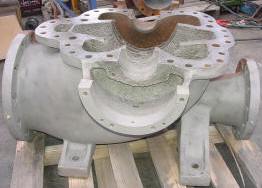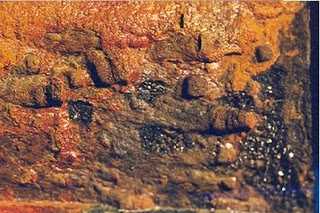

“Pumping and Hydraulics’ Solutions for Irrigation and Water Supply”

ABN: 92 105 345 506
Coatings for Pumps and Pipes
This section looks at three areas of coatings:
A) Pump Internal Coatings
A good pump internal coating has several basic requirements:
A good pump internal coating has several basic requirements:
Pump internal coatings are usually the domain of cast iron pumps only. Cast iron, when submersed in water for long periods of time, undergoes two phenomena:
a)Iron hydroxide tubercles form on the surface (similar to inside a pump body, right), increasing surface roughness which has a devastating effect on pump efficiency.
b)Iron dissolves from the carbon-iron matrix and leaves a porous honeycomb (graphitized) mass which both weakens the cast iron and also reduces the adhesion of any surface coating. These voids also fill with water, further propagating corrosion with the effects of differential oxidation.
b)Iron dissolves from the carbon-iron matrix and leaves a porous honeycomb (graphitized) mass which both weakens the cast iron and also reduces the adhesion of any surface coating. These voids also fill with water, further propagating corrosion with the effects of differential oxidation.
Preparation and coating
To overcome these issues, it is important to grit blast a stripped cast iron pump casing and then heat it to, say, 150deg C for 12 hrs to “sweat” the water from the voids. Let the casting cool, and grit blast again, and then reheat. This process may need to be repeated 3 times until all remnants of water are removed from the cast iron surface. Caution: If the pump is very old, excessive grit blasting may completely remove the graphitized cast iron and leave a hole in the pump casing, so caution is needed when grit blasting!
Filling the “cavities”: After grit blasting, any corrosion “cavities” in the casing surface may need filling with an epoxy filler and only then can an effective coating be applied. Modern pump coatings such as Belzona are metallic based which, whilst very costly, are extremely beneficial to long term pump performance. These coatings have a much higher percentage of solids, around 65% to 80%, compared to 25% for conventional domestic coatings.
To overcome these issues, it is important to grit blast a stripped cast iron pump casing and then heat it to, say, 150deg C for 12 hrs to “sweat” the water from the voids. Let the casting cool, and grit blast again, and then reheat. This process may need to be repeated 3 times until all remnants of water are removed from the cast iron surface. Caution: If the pump is very old, excessive grit blasting may completely remove the graphitized cast iron and leave a hole in the pump casing, so caution is needed when grit blasting!
Filling the “cavities”: After grit blasting, any corrosion “cavities” in the casing surface may need filling with an epoxy filler and only then can an effective coating be applied. Modern pump coatings such as Belzona are metallic based which, whilst very costly, are extremely beneficial to long term pump performance. These coatings have a much higher percentage of solids, around 65% to 80%, compared to 25% for conventional domestic coatings.
Iron hydroxide tubercles inside a pump body after several years in service. Photo R Welke

Good quality coatings will last 10 years or more inside of pumps. There are numerous companies Australia wide that offer pump coating services.
It should be noted that if the cast iron pump surface isn't grit blasted/heated/grit blasted, the coating longevity will be greatly reduced (unless of course the cast iron is brand new).
Because of the high coatings cost and intensive labour activities to successfully coat a pump internal surface using the above method, it is probably only economical on pumps over 100kW.
It should be noted that if the cast iron pump surface isn't grit blasted/heated/grit blasted, the coating longevity will be greatly reduced (unless of course the cast iron is brand new).
Because of the high coatings cost and intensive labour activities to successfully coat a pump internal surface using the above method, it is probably only economical on pumps over 100kW.
Source: linkpumps.com.au -A grit blasted pump ready for coating.
An interesting side note here: Pump Tests have shown pump performance improvements of up to 4% with just two coats of a low cost coating such as a domestic Gloss Enamel. However, this type of paint will not remain adhered to submersed cast iron surfaces and hence its effectiveness will be lost within weeks, or even days.
B) Pipe Internal Coatings
Mild steel pipes are most commonly hot dip galvanized for corrosion resistance.
Mild steel pipes are most commonly hot dip galvanized for corrosion resistance.
Zinc has a limited life when immersed in water and is not generally a good pipe internal coating. Its real advantage is in the external coating
However, galvanized pipe is widely used in the water industry because it is much cheaper than the alternative stainless steel pipe if a metal pipe is required.
The secret to successful galvanized pipe for irrigation or potable water use is to ensure a good pipe thickness so that when the zinc does eventually dissolve from the internal surface, there is plenty of steel thickness to resist corrosion pitting from penetrating the pipe wall.
However, galvanized pipe is widely used in the water industry because it is much cheaper than the alternative stainless steel pipe if a metal pipe is required.
The secret to successful galvanized pipe for irrigation or potable water use is to ensure a good pipe thickness so that when the zinc does eventually dissolve from the internal surface, there is plenty of steel thickness to resist corrosion pitting from penetrating the pipe wall.
The hot dipped galvanizing on the inside of this pump manifold pipe has dissolved after 20 years service, and pitting corrosion has commenced. Heavy pipe wall has saved it from catastrophic failure. Photo R Welke
For example, a stainless steel pipe of 1.6mm thick may last 20 years easily. But a 1.6mm galvanized steel pipe will probably last for a year, or even less with aggressive water. It will be necessary to increase galvanized steel pipe wall thickness to, say, 8-10mm to give it 20 years life. Hence the default standard for some irrigation pumping plants is Schedule 40 steel pipe.
C) Pipe External Coatings
Galvanised pipe is best left uncoated on the outside, ESPECIALLY if the pipe is to be submerged.
The zinc coating protecting the outside surface from corrosion can only do its job if there is a large area of zinc to protect small scratches in the zinc surface.
The protective mechanism is such that the surrounding zinc acts as an anodic protector to the bare steel scratch in the surface.
In time, the zinc surrounding the scratch will diminish and years afterwards, there will be a larger area devoid of zinc around the
The zinc coating protecting the outside surface from corrosion can only do its job if there is a large area of zinc to protect small scratches in the zinc surface.
The protective mechanism is such that the surrounding zinc acts as an anodic protector to the bare steel scratch in the surface.
In time, the zinc surrounding the scratch will diminish and years afterwards, there will be a larger area devoid of zinc around the
This immersed galvanized pump riser pipe has developed a “holiday” in its coating, resulting in deep pitting corrosion. It would have been better off unpainted. Photo R Welke
original scratch, resulting in a slightly corroded surface, but no pitting corrosion.
However, if the zinc coated pipe is painted for aesthetics, as in the photos above and right, there is no anodic protection available to protect the scratched area.
The scratch then degrades to deep pitting corrosion (above), or catastrophic failure (right). and turns very ugly.
In this case, corrosion occurred from the outside painted surface inwards, much faster than from the zinc coated inside surface outwards.
However, if the zinc coated pipe is painted for aesthetics, as in the photos above and right, there is no anodic protection available to protect the scratched area.
The scratch then degrades to deep pitting corrosion (above), or catastrophic failure (right). and turns very ugly.
In this case, corrosion occurred from the outside painted surface inwards, much faster than from the zinc coated inside surface outwards.
Stainless Steel pipe is self-passivating whenever its clean surface is exposed to enough oxygen to form the chromium rich oxide surface layer, on which the corrosion resistance of these alloys depends. If stainless steel pipe is coated, it will be unabe to self passivate and any holiday in the coating will lead to rapid pitting corrosion at that holiday. Thankfully, stainless steel is difficult to bond any coating to.
Iron hydroxide tubercles on a pump riser pipe from constant immersion in water. Note also a small “holiday” in the coating has resulted in catastrophic failure. The pipe would have been better off unpainted Photo R Welke
Powder Coated steel.
A good powder coating is probably one of the best and most effective metal coating.
However, the effectiveness of powder coating is totally reliant on there being absolutely NO voids in the coating (known as “holidays” in the coating industry)
.
Once a powder coated surface is scratched, cracked or holed, it’s goodbye Charlie! The hole becomes an anode and the surrounding coating becomes the cathode, resulting in rapid crevice corrosion under the coating caused by differential oxidation.
A good powder coating is probably one of the best and most effective metal coating.
However, the effectiveness of powder coating is totally reliant on there being absolutely NO voids in the coating (known as “holidays” in the coating industry)
.
Once a powder coated surface is scratched, cracked or holed, it’s goodbye Charlie! The hole becomes an anode and the surrounding coating becomes the cathode, resulting in rapid crevice corrosion under the coating caused by differential oxidation.
This quickly propagates under the adjoining coating and lifts it to rapidly expand the corrosion area, as in the photo, right.
It appears that the coating was damaged by the nut fracturing the coating during tightening. A larger washer with a polyurethane underlay would have helped.
There is no good recovery from a damaged powder coating. Any repairs will be short lived. Damaged areas may be grit blasted or wire brushed at minimum, and then over-coated with epoxy 2 part paint, but it’s only a temporary fix.
The ultimate solution is to grit blast all of the powder coating and start again.
It appears that the coating was damaged by the nut fracturing the coating during tightening. A larger washer with a polyurethane underlay would have helped.
There is no good recovery from a damaged powder coating. Any repairs will be short lived. Damaged areas may be grit blasted or wire brushed at minimum, and then over-coated with epoxy 2 part paint, but it’s only a temporary fix.
The ultimate solution is to grit blast all of the powder coating and start again.
Background
Rob obtained most of his coatings experience from SA Water activities, initially from pump internal coating experiments in the 1970’s when he conducted numerous pump tests to monitor experimental pump coatings on large horizontally split casing CI multistage pumps.
He later became involved with SA Water Workshop activities where state of the art pump coatings were applied to irrigation pumps (up to 5000kW) in the Riverland Region Workshops. Rob was Executive officer of the Mechanical Superintendants Conferences of all Regional Workshop Superintendants for several years in the late 1980’s during the period when all of the major irrigation pumping plant there was refurbished from pumps with gland packing to pumps with mechanical seals and high tech pump coatings.
With the vast bank of coatings knowledge that Rob has, Tallemenco can ensure that all of its projects' components will be optimally coated for the best possible life.
Rob obtained most of his coatings experience from SA Water activities, initially from pump internal coating experiments in the 1970’s when he conducted numerous pump tests to monitor experimental pump coatings on large horizontally split casing CI multistage pumps.
He later became involved with SA Water Workshop activities where state of the art pump coatings were applied to irrigation pumps (up to 5000kW) in the Riverland Region Workshops. Rob was Executive officer of the Mechanical Superintendants Conferences of all Regional Workshop Superintendants for several years in the late 1980’s during the period when all of the major irrigation pumping plant there was refurbished from pumps with gland packing to pumps with mechanical seals and high tech pump coatings.
With the vast bank of coatings knowledge that Rob has, Tallemenco can ensure that all of its projects' components will be optimally coated for the best possible life.
This photo shows a failed powder coating on a handrail post base, with crevice corrosion penetrating under the failed coating and propogating it further. Photo R Welke


A) Pump Internal Coatings
B) Pipe Internal Coatings
C) Pipe External Coatings
B) Pipe Internal Coatings
C) Pipe External Coatings
1) Provide a smooth surface to reduce water friction and maintain high pump efficiency
2) Resist abrasion/chemicals, thereby reducing erosion corrosion, (impingement attack)
3) High adhesion, thereby preventing corrosion attack of the base pump material
(eg cast iron), and prolonging the effectiveness of the smooth surface.
2) Resist abrasion/chemicals, thereby reducing erosion corrosion, (impingement attack)
3) High adhesion, thereby preventing corrosion attack of the base pump material
(eg cast iron), and prolonging the effectiveness of the smooth surface.
Last Update
Nov 8th 2019
Nov 8th 2019
Tallemenco Pty Ltd, Windsor Gardens, SOUTH AUSTRALIA, 5087.
ABN: 92 105 345 506
Mobile 0414 492 256
Intn'l: Cell +61 414 492 256
Skype: robwelke
ABN: 92 105 345 506
Mobile 0414 492 256
Intn'l: Cell +61 414 492 256
Skype: robwelke